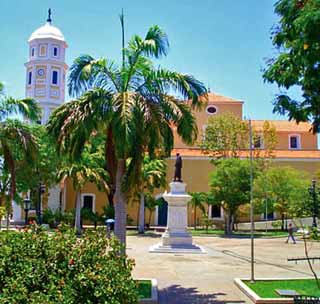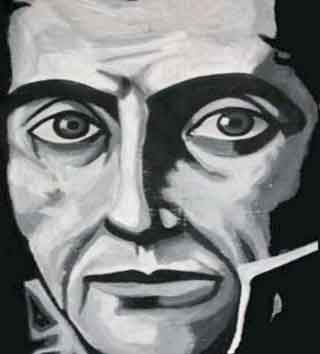Around 1765 the town of Santo Tomé de Guayana de Angostura del Orinoco was developed at the point where the Orinoco is at its most narrow; about 1 mile (1.6 km) wide. Due to the strategic importance of this location and the wealth of natural resources found in the region, the Spanish Monarchy constructed a cathedral church, government buildings and a central plaza. In its early years Angostura suffered frequent attacks by pirates who would sail up the Orinoco River from the Caribbean Sea.
In 1817 the city fell under the control of the anti-colonial revolutionary forces led by the military commanders Simón Bolívar and Manuel Piar, subsequently executed as a traitor by order of Bolívar. Angostura became the Supreme Headquarters of the nascent Republic. Two years later, in a famous speech in front of a National Congress of revolutionary leaders Bolívar outlined his vision of the political future of Venezuela, and of Spain’s other South American colonies. He was declared President of the not yet independent Venezuela, part of a greater ‘Gran Colombia” federation that would (for a very short period) come to include present-day Panama, Venezuela, Colombia, Ecuador, and Peru. The importance of this Congress, and his subsequent achievements as ‘Liberator’ of Gran Columbia, were recognised here in 1846, when Angostura was renamed Ciudad Bolívar.
Today the city is the capital of Venezuela's south-eastern Bolívar State with a population of around 350,000. It is an important port on the Orinoco River for the eastern regions of Venezuela, with a local economy dependent on agriculture, gold, iron ore, cattle, leather and rare woods. A tonic derived from a locally-harvested small, shrub-like tree (Cusparia febrifuga) traditionally used to reduce fever, became famous throughout the world as ‘Angostura Bitters’.
If you are staying for a day or two in the city on the way to or from Angel Falls, you should visit the historic Old Town. Interesting buildings include San Isidro Museum (where Bolívar drafted the speech that he delivered to the Congress), Parochial House, the Old Prison, the Government Palace, the House of the Congress of Angostura (now a museum), the Cathedral church and the central square of Plaza Bolívar. Art lovers might enjoy the Museum of Modern Art, created by sculptor and painter Jesús Rafael Soto. featuring works by Venezuelan and international artists. Another landmark is the Angostura Bridge, the first bridge across the Orinoco River.
Simón Bolívar
Son of a wealthy land-owning family originally from the Basque country and the Canary islands, his parents died when he was young. In his teens he was educated at a military academy in Spain. He was also greatly influenced by the teacher Simon Rodriguez, who introduced him to the political ideals of the European Enlightenment, the American Revolution against British rule, Freemasonry, the French Revolution, and Napoleon Bonaparte.
The occupation of Spain by France during the Napoleonic Wars, and the replacement of the King by a ‘puppet government’ of Spanish collaborators under Napoleon’s brother, led people in Spain’s South American colonies to rise up against the colonial power, sometimes in the name of the Spanish King himself. Divisions within the criollo (born in the Americas) ‘revolutionaries’, reflected the great political schism in Europe, between traditional wealthy, land-owning, aristocratic and pro-monarchistic Conservatives, and the Liberal movement emerging with a new ‘Middle class’ of merchants and industrialists that promoted economic free trade and political democracy. Bolívar attracted financial, military and political support from a sufficient number of criollo leaders from across this divide to allow him to realize (briefly) his dream of a unified postcolonial South America.
His visionary idealism in speeches promoting freedom for all native born criollos – including the landless poor, African slaves and indigenous Amerindians – ensured for a time his popular support amongst the masses. However his own political analysis, presented at the Angostura Conference, was that a union of newly-independent South American states was not suited – because of colonial history and the ignorance and backwardness of its peoples – for the type of democratic federal governmental model adopted in the USA after the 1776 War of Independence. Instead, Bolívar proposed a British-style system based on a President-for-life commanding a centralized state, and ruling with the support of a Senate whose members would be selected on the hereditary principle. This analysis – reinforced by his own absolute self-belief in his unique role as ‘Libertador’ – compelled him often to seek authoritarian dictatorial powers and to turn ruthlessly against any former ally who refused to accept his position. His refusal to consent to a Federalist and more decentralised system finally led to the violent disintegration of the Republic of Gran Columbia and his forceful rejection both by regional strongmen and local elites (including in Venezuela) who refused to recognize his supreme power. He died a bitter and broken man, his name and reputation tarnished.
However, within 20 years of his death, his enormous contribution to the anti-colonial struggle began to be publicly acknowledged and even idolized. This veneration of Bolívar was particularly notable in Venezuela, his birthplace, as his physical image, if not his vision, was appropriated during the 19th century by nation-building dictators seeking to create a heroic national political narrative. Plazas de Bolívar (central Squares) were created in virtually every Venezuelan town and city. Current President Hugo Chavez has also tried to selectively utilize the legend of Bolívar to promote his own vision of Venezuelan democracy and regional integration.





